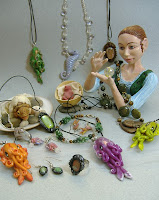
For my first site review here on Handmade Biz I'm going to cover a site that doesn't let you sell handmade products directly but has some very useful services for your business.
Zazzle.com is a print on demand site that also lets you sell your designs through them and make money. This is especially useful for those working in 2D media like pencil, paint, or digital art in that you can offer your artwork for sale on a wide variety of products at no direct cost to you. It's a fun additional way to promote your art work.

Zazzle offers a really wide and unique variety of products to put your designs on from clothing to bag to cards to skateboards. They even offer embroidered designs though those require an upfront artwork processing fee. When you sign up you get your own customizable storefront, you can take a look at
Noadi's Art on Zazzle to see my store as an example. The way you make money on Zazzle is when you create products with your designs you can add them to the marketplace (which will put it on your store along with in Zazzle's search) and put a percentage markup over the base price on each product, if someone buys one you get that percentage. When you make products to buy yourself you pay the base price.
What makes Zazzle really useful for a handmade business is their paper printing options, they offer business cards, postcards, greeting cards, stickers, and postage. All of these can be used to create your own promotional products which is exactly what I used Zazzle for this week. You could also make custom t-shirts to promote your business and wear them to craft shows.
I was running out of my home printed business cards and decided that I really wanted some that looked more professional so I looked around at different online printing services and not surprisingly there is a huge range of prices available depending on quality of the cards and whether you want color and two-sided printing. I wanted full color with two sides and Zazzle's prices were pretty good and I already had an account with them so I decided to give them a try.

First I had to design my cards. Zazzle has pre-made templates already that make designing a card really easy or you can upload your own images and then you can add whatever text you want. I wanted a little more control over my design than that so I downloaded a business card template and used my own photos and the Gimp photo editor to design my card. I then uploaded my images and deleted all the text boxes that Zazzle puts in automatically for business cards.
I went through the order process, Zazzle was having a half-off promotion for business cards so I only paid $25 for 300 cards which was the lowest price I found for 2-sided full color printing, even the full price of $50 for 300 was in the middle of the price range I found. You can find much cheaper business card printing but those usually restrict your design choices and/or put their logo on your cards.
I was given a delivery estimate of 6-10 days after printing. Printing apparently doesn't take very long because they shipped the next day and I received them in only 4 days which is impressive considering I'm on the other side of the country from Zazzle's headquarters.
So my opinion of the cards? They are gorgeous, the cards are a nice weight of cardstock, a satin finish (just a little more glossy than matte), colors are bright and the images are very crisp not grainy. Overall I'm very impressed.

 I plan to do a much larger post specifically on some of the ad networks later on but after a Twitter exchange today I wanted to write a short post about setting up an ad campaign. I've had some moderate success with ad campaigns using Project Wonderful so I feel like I have learned something about what works and what doesn't.
I plan to do a much larger post specifically on some of the ad networks later on but after a Twitter exchange today I wanted to write a short post about setting up an ad campaign. I've had some moderate success with ad campaigns using Project Wonderful so I feel like I have learned something about what works and what doesn't.











